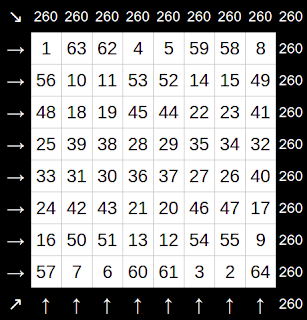 |
Ashtāpada: the uncheckered 8x8 board |
64 six-line figures or "hexagrams" (e.g. ䷄), each with associated judgments, imagery, and texts. May be written using line drawings: ⚊ ⚋ or with strings of binary digits; for example: 010111b is a binary expression of the hexagram figure above.
I Ching ARRANGEMENT
Ashtāpada, the uncheckered 8×8 board, of Hindu derivation. The literal meaning of "ashtapadi" is "eight steps." This word is the origin of the word ashtāpada, an Indian board game, the forerunner of chess. The word now primarily refers to the board itself.
- Related to the game Chaturanga: (Sanskrit: "four-limbed"), the ancestor of modern chess
- Related to Manduka/Chandita mandala
- Populated by the 64 hexagrams, it represents 2080
- Characterized as a "field of action [activity]," indicating the body, or even the Universe suggesting perhaps the identity relation between these
- related to "kshetra," meaning 'field' or 'body'
- related to Vastu-Purusha mandala
- q.v. Bhavagad Gita: ch. 13
- q.v. Ta Chuan p1:c11:v5-6
- q.v. "Symbolism of Chess," Titus Burkhardt
I Ching SYNTAX
Xian Tian, a symmetrical arrangement of 32 pairs of binary complements over the ashtāpada.
- Any given hexagram on the ashtāpada has a complement at 180 degrees of rotation
- The binary values of each complementary hexagram pair sums to 65
- The expression 64!! (double factorial), equal to [64*62*60...8*4*2] computes the xian tian arrangements that can exist
 |
| Xian Tian magic square |
- XMS produces two proper partitions of the populated ashtāpada.
- The eight rows constitute a partition, the eight columns constitute another partition, and the diagonals comprise two additional octonary collections for a total of 18 linear octets.
- The author is presently unclear how to calculate the number of xian tian arrangements that obey the magic square restriction, though it is obviously a subset of total number of xian tian arrangements .
Circular arrangement of the Armanen runes |
In this discussion, the sixty-four 6-bit hexagrams serve as the words or runes. Therefore each of the eighteen collections comprises a unique combination of eight 6-bit "words." Each of our "spells" consists of eight words (alternatively, eight hexagrams or runes), having a numerical or numerological value of 260.
Words certainly imply 'spells' and 'spelling,' as to spell a word is to precisely enumerate its letters in correct sequence. The word 'gospel,' for example, literally means "good spell," or "good word."
Words and runes are symbolic representations of ideas. Runes are fairly distinct from letters, it seems, since individual letters seem devoid of semantic value viz. the word in which they appear; while runes preserve a measure of their individual meanings in isolation. Additionally, runes seem more akin to words in a phrase than to letters in a word.

No comments:
Post a Comment